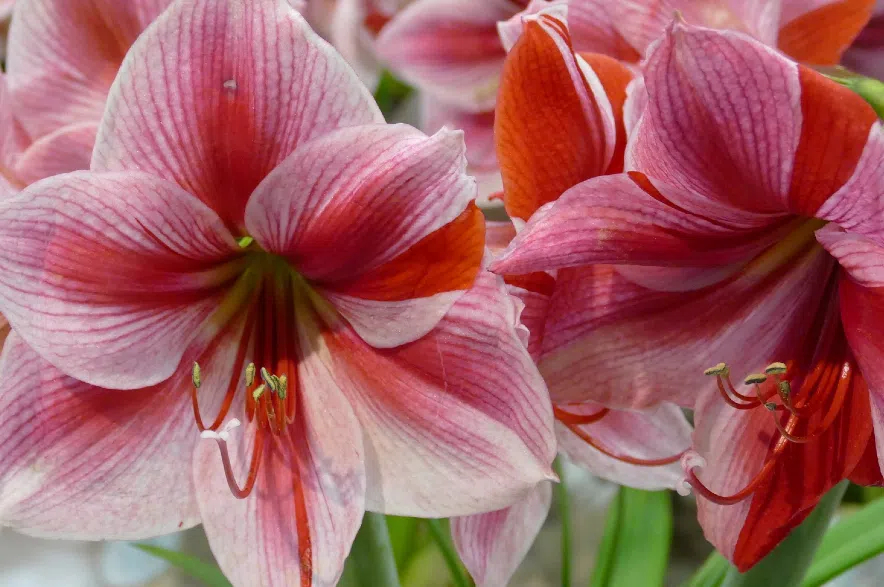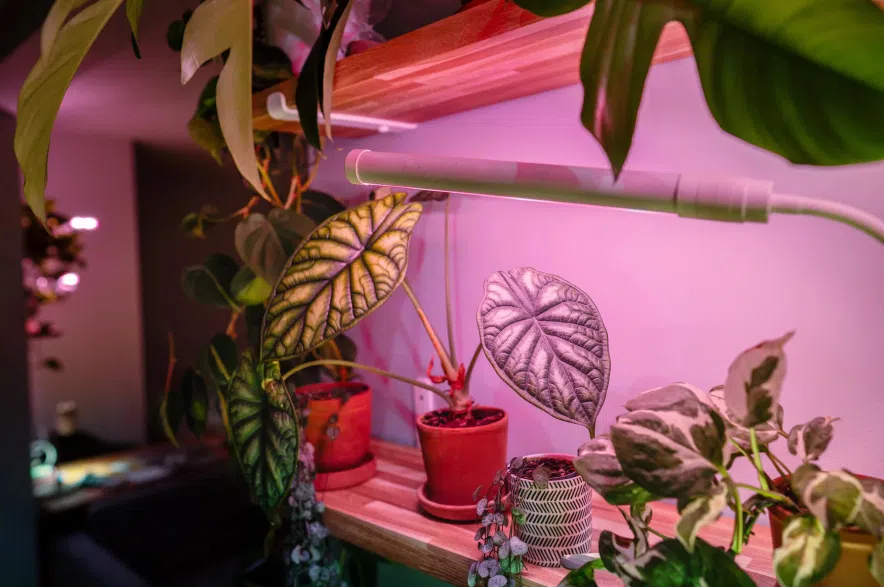Jill and Rick Van Duyvendyk answer all your gardening questions in Garden Talk on 650 CKOM and 980 CJME every Sunday morning from 9 a.m. to 11 a.m.
Here are a selection of questions and answers from the Nov. 3 episode:
Q: What is the best way to set up an indoor grow room?
I work at a long-term care facility in Melfort and we have a room in the centre of the facility that does not get natural light.
We would like to grow indoor house plants as well as winter some outside plants. Can we just replace the regular fluorescent bulbs with grow lights?
A: If you just replace the regular bulbs with full spectrum grow lights, remember it’s the distance that the grow light is away from the plant that makes a difference, too. If you’re going to be starting seeds, your grow light has to close to them.
If you’re wanting to propagate something and get a lot of new growth you have to put it a little bit closer than for something like a snake plant, ZZ plant or low-light tropicals where a grow light in the ceiling would be enough.
Any tropical plant that you’re putting indoors means you’ve taken it out of its natural habitat, so what you’re really doing is prolonging its life, but it is slowly dying because it’s not in its natural habitat. It might take 10 or 15 years, it might take five
years.
In an indoor space, you also need a management program in place for checking for bugs, topping up the soil, fertilizing, and for replacing some of those plants over time. Chinese evergreen or cast iron plant would be awesome in that area. Even some of the dracaena would be great, too.
As well as the main lights, there are lots of smaller grow lights that you can use as well that are like desktop lamps. Some look like little orbs or mushrooms that you can put at different levels above the plants You can also get LED strip lighting that will help increase the light level, too.
See Dutch Growers guide to caring for houseplants in winter here.
Q: Can I maintain herbs indoors in winter without grow lights if I don’t have a southern window?
A: It is tricky maintaining herbs indoors without grow lights, whether or not you’ve got a southern window or not, because of the short daylight hours in the winter and the fact that you can’t put the herb right against the glass because it’s too cold.
The best thing is to add a grow light about 12 to 14 inches from the plant and continue to fertilize with a good organic blend of fertilizer. Certain herbs indoors germinate better by seed, like basil, parsley, and chives. Woody ones like tarragon and rosemary are better done from cuttings.
Read more
- Garden Talk: Don’t let Saskatchewan winter kill your water garden
- Garden Talk: Do mushrooms at a tree base need to be removed?
- Garden Talk: Protect your trees from pests over winter
- Garden Talk: What maples in Saskatchewan get red leaves in fall?
Q: Can I still apply fertilizer in November in Saskatchewan, or is it too late?
A: It depends what you’re fertilizing. You can probably apply some lawn fertilizer but it’s getting a little bit late right now unless it’s going to rain, otherwise wait until spring. You can apply organic fertilizer to trees and shrubs despite the fact they’re dormant right now, that fertilizer will be there for next spring. Just organic, not a 30-10-10 or similar.
For indoor plants, start to slow down on fertilizing. If you are using fertilizer drops every time, you can continue to do that as it’s such as low amount but if you’re fertilizing once a week when they’re actively growing, remember our daylight hours go down so the less the you’re watering, the less you want to fertilize.

You can keep amaryllis and force the bulbs to bloom year after year. (University of Saskatchewan/submitted)
Q: I stopped watering my amaryllis at the end of August and put it in the basement in the dark in the middle of September, but the leaves are still green and haven’t died off. Should I cut them off and try to force it or wait?
A: Wait a little bit longer but if you’ve if you’ve let it go dormant for a little bit you can cut them off. You can even put the plant in a fridge or a fridge crisper away from any fruits and vegetables to help it go to dormant. It is possible it’s not getting cold enough, most basements are cool but still probably 12 or 15 deg C. Try putting it in a cooler area and see if it works, around five deg C, to shock the plant.
You can even transplant it, — just remove a little bit of the soil, not all of it, and that disturbs the root system. You can put it back in the same pot again or if it’s a big bulb, put it in a slightly bigger pot, which can reset it as well.
When you’re planting an amaryllis in soil, make sure that you don’t have more than an inch of soil all the way around. If the pot is too big, it’s going to hold too much moisture, If you put multiple bulbs in one pot, make sure they’re not touching each other.
Q: I have perennials in my front flower beds, should they be cut back to the ground? Can I cover them with the cuttings or should I just toss those and use mulch?
A: You can do it either way. It depends on when you like to clean up and how much snowfall you get in your yard. If you have an open area where the snow blows, leave the perennials up and do the cleanup in the spring. If you get lots of snow around the house, and like to have a clean yard in the spring, cut everything down to the ground in the fall. Make sure that when you are cutting them down to the ground, you’re not pulling them out. Don’t leave the cuttings as mulch if there are any diseases or fungus.
Q: How do I keep geraniums over the winter?
A: Bring them indoors and spray them with End-All or rinse with insecticidal soap to remove any bugs. With the change in light, they’re probably going to drop about one third of their leaves right away. That’s completely normal.
You can keep the mother plant growing in a south-west window until January, or February. In the fall, trim a mother plant down about one third to one half of the
size to keep it bushy and to get new growth on it throughout the winter.
In December, and January, cut back any new growth again, allow it to grow again a little bit then take cuttings or slips off of that. Dip those in rooting hormone grow new plants starting about end of January, beginning of February. Those are new plants for the spring right and the mother plant gets discarded or trim it right back before you put it outside so it doesn’t get lanky and weak.
Another way you can do it is to decrease your watering, cut it back and then put it in a basement window so the plant goes dormant — it will lose a lot of its leaves but it will still be alive. Just touch it up with water every once in a while but it’s going to look really ugly. Then cut it back, take the new growth tips off and pot those up for next year.
Q: How do I ripen pears I have grown? Nothing seems to work and they seem to always rot.
A: Putting unripe pears in a paper bag with another piece of fruit, means the ethylene from that will help to ripen it. Bananas are best because they give off the highest amount of ethylene gas. The longer you can keep pears on the tree before a frost, the more likely they’re going to ripen.
Newer varieties like Golden Spice and Early Gold tend to ripen quicker but the old varieties can be like hockey pucks. You can always wrap your tree with a frost blanket if you want to keep the fruit on the tree longer, but that only works for so long because pear trees get to be pretty big.
Q: What’s the difference between Roundup and Roundup Advanced?
A: Roundup Advanced is actually like horticultural vinegar. It doesn’t have glyphosate in it. It coats the leaf and burns it, and it’s safer to use and it doesn’t kill the roots. Roundup will kill anything green.
Q: I harvested, dried and hung my onions as usual. There was no evidence of spoilage when harvested but now they’re rotting. What is causing this?
A: Sometimes if onions are quite moist when they came out of the ground and are touching each other when they’re hanging they can start getting rotten spots where they are touching. You can lay them on cardboard to dry a little bit before hanging and then store them in a mesh bag after they dry. The storage area should be well
ventilated as well.
Read more







